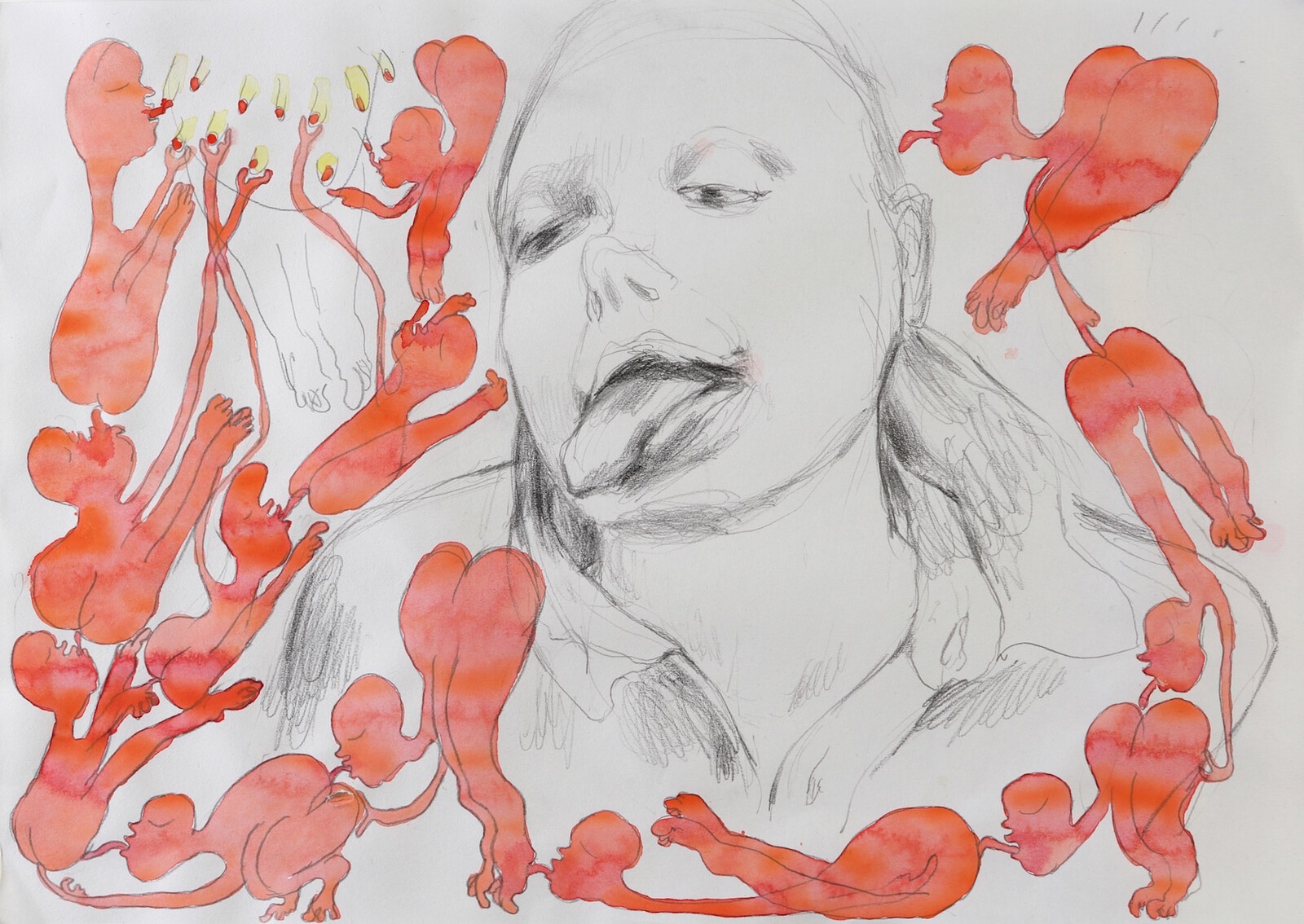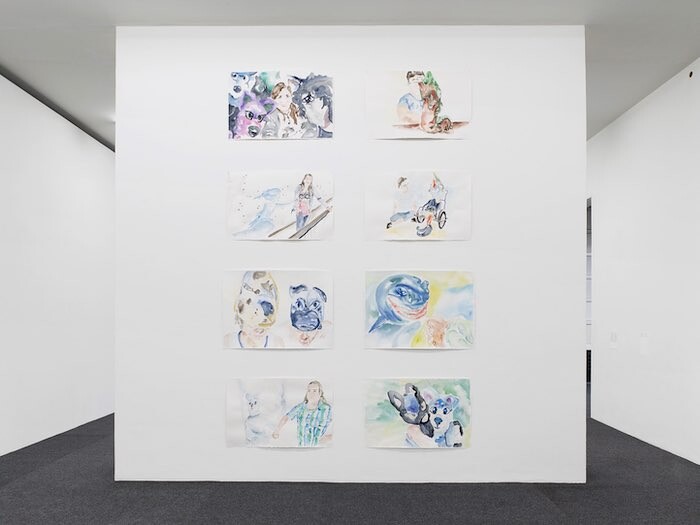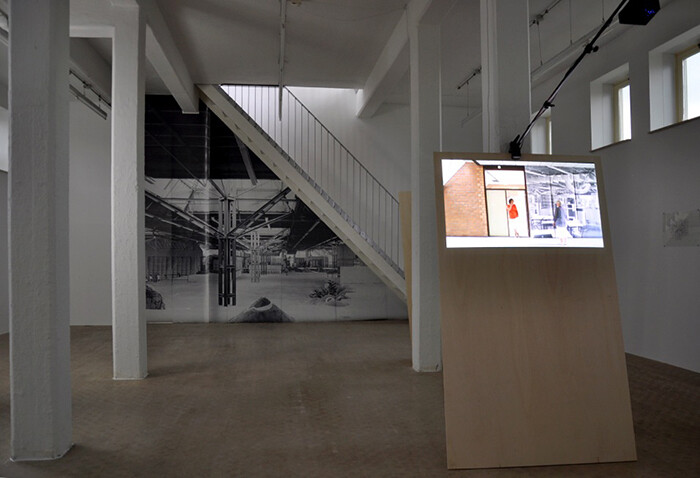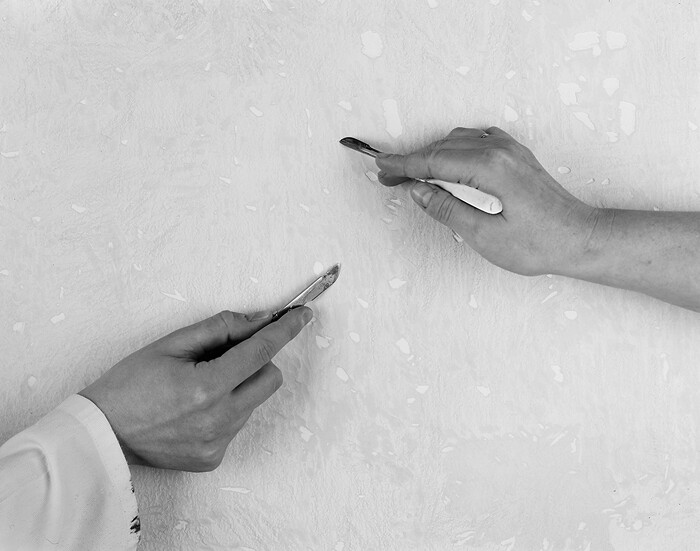Categories
Subjects
Authors
Artists
Venues
Locations
Calendar
Filter
Done
December 20, 2022 – Review
Beatriz Santiago Muñoz’s “The Navel of the Dream”
Natasha Marie Llorens

Watching Beatriz Santiago Muñoz’s silent 16mm film Otros usos [Other uses] (2014) is like looking into a kaleidoscope made with old snapshots too nondescript to make it into an album but nonetheless strangely fascinating. A composite image of four shots of a tranquil sea, each aligned to the edges of the frame, spins in a circle. As they oscillate, the distant shoreline in each shot tilts and merges with the next. The anachronistic sound of the projector, installed on a pedestal in the gallery, combines with the faint heat produced by the machine to heighten the body’s senses, like the effect of ASMR. I feel that Muñoz wants me, the viewer, to feel disoriented, employing a combination of the images’ banality and their movement to lull me into a dream state. They want to suspend my desire for narrative resolution and a fixed horizon.
Both Otros usos and another silent 16mm film projected beside it, Black Beach/Horse/Camp/The Dead/Forces (2016) do have a precise physical referent: the island of Vieques in the Caribbean near Puerto Rico that the US Navy used as a bombing range and a training ground for over sixty years. In Otros usos, Muñoz’s carefully folded image is …
April 23, 2020 – Review
Andrea Éva Győri’s “Bold Head With Tongue”
Vivian Sky Rehberg

Two weeks into my home confinement, the New York City health department advised that, during the Covid-19 outbreak, “you are your safest sex partner.” A few days later, the New York Times ran a feature on nonagenarian sex educator and artist Betty Dodson, author of Sex for One: The Joy of Loving (1987). It therefore felt fitting that my first expedition, when I hauled myself away from the news, should be a visit to Wilfried Lentz’s new Rotterdam gallery to see “Bold Head with Tongue,” an exhibition of paintings and drawings by Andrea Éva Győri, who has spent a number of years studying and depicting female masturbation, fantasies, and orgasm.
“Bold Head with Tongue” draws on themes of female desire which have long preoccupied Győri. For Manifesta 11, hosted by Zürich in 2016 and entitled “What People do for Money,” Győri, like all the participants, paired up with a local professional from outside the contemporary art world. She worked for five months with a clinical psychologist/sexologist, participated in a practical masturbation course, and later held private sessions in which she drew women masturbating. In addition to exhibiting her drawings, Győri published her research in a weighty artist’s book titled Vibration …
November 7, 2018 – Review
Opening Fall Exhibitions
Vivian Sky Rehberg

In January 2018, Sofía Hernández Chong Cuy took over as director of Witte de With Center for Contemporary Art, replacing Defne Ayas who, like me, started working in the Dutch “second city” in 2012. Witte de With’s directors are initially hired for three years and their contract can be renewed once for a finite six years. This sets a tempo and creates momentum for the institution and its publics, which anticipate structural transitions and shifts in direction and content that impact the institution’s identity and legacy.
You might have noticed that Witte de With has been the focus of attention lately. The contemporary art center celebrated its 25th anniversary in 2016, during Ayas’s tenure, and she developed a number of exhibitions, publications, and public programs around institutional histories and heritage. These include the fascinating “Rotterdam Cultural Histories” displays Witte de With still co-produces with the art center TENT, which is housed in the same building on Witte de Withstraat, and whose local mission is to support artists based in the city. In addition, Ayas invited Rotterdam-based artist-duo Bik van der Pol—Liesbeth Bik and Jos van der Pol—to work closely with Witte de With’s staff on the 2016 exhibition “WERE IT AS …
October 29, 2014 – Review
Wendelien van Oldenborgh’s “Footnotes to Beauty and the Right to the Ugly”
Vivian Ziherl

The first week of October proved exceptional for Wendelien van Oldenborgh. As an awardee of the 2014 Heineken Prize for Art—the Netherlands’s wealthiest prize—the artist and filmmaker had swept through a schedule of lectures, media appearances, and finally a private audience with the Dutch monarch. For an artist best known for her incisive critiques of unspoken tensions—Dutch colonial legacies and the flaws in the nation’s armature of “tolerance,” for example—these were opportunities not to be missed. In a fitting homecoming, the week ended with a Sunday evening opening of an exhibition of new work in Rotterdam, the artist’s hometown.
“Footnotes to Beauty and the Right to the Ugly,” at Wilfried Lentz, is a collection of filmic and documentary materials continuing van Oldenborgh’s research into Dutch social infrastructures, yet one that perhaps marks a new spatial turn in her practice. Elements of a film fill the gallery space: videos on self-supporting projection units, a wallpaper, and architectural diagrams. In these fragmented components, viewers encounter the debris of the 1970s Dutch ideals of maakbaarheid [social engineering] and an “open society” amid the Foucauldian double-bind of a utopic reinvestment in life against the commoditized reality of lifestyle.
In the tradition of cinéma vérité, van Oldenborgh …
November 21, 2012 – Review
Hito Steyerl’s “Adorno’s Grey”
Adam Kleinman

In 1969, amidst growing student protests across Germany, three female students bared their breasts during a lecture by Theodor W. Adorno; they then proceeded to shower him with flower petals. This protest, as it were, was a probable rebuttal to the German philosopher’s summoning of the police to forcibly remove members of an activist group, Students for a Democratic Society (SDS), from occupying the Institute of Social Research earlier that year. According to most accounts, Adorno ran out of the room in horror, leaving not only that day’s lecture unfinished, but also to never properly return to teaching again. In fact, he withdrew from public life altogether so as to finish his tome Aesthetic Theory, which was, ironically, on the interrelation of art and social critique. That too was a task he would never complete. He died soon after these events, leaving the unfinished text to be edited and published posthumously.
Although this sultry, and ultimately tragic drama quickens the pace of one of several narrative threads in Hito Steyerl’s filmic installation Adorno’s Grey (2012), now on view at Wilfried Lentz in Rotterdam, a fair amount of concentration is demanded of the viewer when visiting the exhibition in toto. This …
